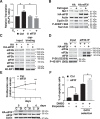Estrogen receptor α promotes protein synthesis by fine-tuning the expression of the eukaryotic translation initiation factor 3 subunit f (eIF3f)
- PMID: 30573685
- PMCID: PMC6378971
- DOI: 10.1074/jbc.RA118.004383
Estrogen receptor α promotes protein synthesis by fine-tuning the expression of the eukaryotic translation initiation factor 3 subunit f (eIF3f)
Abstract
Approximately two thirds of all breast cancer cases are estrogen receptor (ER)-positive. The treatment of this breast cancer subtype with endocrine therapies is effective in the adjuvant and recurrent settings. However, their effectiveness is compromised by the emergence of intrinsic or acquired resistance. Thus, identification of new molecular targets can significantly contribute to the development of novel therapeutic strategies. In recent years, many studies have implicated aberrant levels of translation initiation factors in cancer etiology and provided evidence that identifies these factors as promising therapeutic targets. Accordingly, we observed reduced levels of the eIF3 subunit eIF3f in ER-positive breast cancer cells compared with ER-negative cells, and determined that low eIF3f levels are required for proper proliferation and survival of ER-positive MCF7 cells. The expression of eIF3f is tightly controlled by ERα at the transcriptional (genomic pathway) and translational (nongenomic pathway) level. Specifically, estrogen-bound ERα represses transcription of the EIF3F gene, while promoting eIF3f mRNA translation. To regulate translation, estrogen activates the mTORC1 pathway, which enhances the binding of eIF3 to the eIF4F complex and, consequently, the assembly of the 48S preinitiation complexes and protein synthesis. We observed preferential translation of mRNAs with highly structured 5'-UTRs that usually encode factors involved in cell proliferation and survival (e.g. cyclin D1 and survivin). Our results underscore the importance of estrogen-ERα-mediated control of eIF3f expression for the proliferation and survival of ER-positive breast cancer cells. These findings may provide rationale for the development of new therapies to treat ER-positive breast cancer.
Keywords: ERα; breast cancer; eIF3f; estrogen receptor; eukaryotic translation initiation; gene expression; mTORC1; translation.
© 2019 Cuesta et al.
Conflict of interest statement
The authors declare that they have no conflicts of interest with the contents of this article
Figures







Similar articles
-
Phosphoproteome Analysis Reveals Estrogen-ER Pathway as a Modulator of mTOR Activity Via DEPTOR.Mol Cell Proteomics. 2019 Aug;18(8):1607-1618. doi: 10.1074/mcp.RA119.001506. Epub 2019 Jun 12. Mol Cell Proteomics. 2019. PMID: 31189691 Free PMC article.
-
mTORC1 directly phosphorylates and activates ERα upon estrogen stimulation.Oncogene. 2016 Jul 7;35(27):3535-43. doi: 10.1038/onc.2015.414. Epub 2015 Nov 2. Oncogene. 2016. PMID: 26522726 Free PMC article.
-
USP35, regulated by estrogen and AKT, promotes breast tumorigenesis by stabilizing and enhancing transcriptional activity of estrogen receptor α.Cell Death Dis. 2021 Jun 15;12(6):619. doi: 10.1038/s41419-021-03904-4. Cell Death Dis. 2021. PMID: 34131114 Free PMC article.
-
eIF3f: a central regulator of the antagonism atrophy/hypertrophy in skeletal muscle.Int J Biochem Cell Biol. 2013 Oct;45(10):2158-62. doi: 10.1016/j.biocel.2013.06.001. Epub 2013 Jun 13. Int J Biochem Cell Biol. 2013. PMID: 23769948 Free PMC article. Review.
-
Modulation of estrogen receptor alpha activity and expression during breast cancer progression.Vitam Horm. 2013;93:135-60. doi: 10.1016/B978-0-12-416673-8.00004-6. Vitam Horm. 2013. PMID: 23810005 Review.
Cited by
-
Eukaryotic initiation factor 3b regulates the development and progression of breast cancer.Am J Cancer Res. 2023 May 15;13(5):2188-2200. eCollection 2023. Am J Cancer Res. 2023. PMID: 37293180 Free PMC article.
-
A novel tumor suppressor ZBTB1 regulates tamoxifen resistance and aerobic glycolysis through suppressing HER2 expression in breast cancer.J Biol Chem. 2020 Oct 9;295(41):14140-14152. doi: 10.1074/jbc.RA119.010759. Epub 2020 Jul 20. J Biol Chem. 2020. PMID: 32690611 Free PMC article.
-
High-Resolution Transcriptomic Profiling of the Heart During Chronic Stress Reveals Cellular Drivers of Cardiac Fibrosis and Hypertrophy.Circulation. 2020 Oct 13;142(15):1448-1463. doi: 10.1161/CIRCULATIONAHA.119.045115. Epub 2020 Jul 30. Circulation. 2020. PMID: 32795101 Free PMC article.
-
Phosphoproteome Analysis Reveals Estrogen-ER Pathway as a Modulator of mTOR Activity Via DEPTOR.Mol Cell Proteomics. 2019 Aug;18(8):1607-1618. doi: 10.1074/mcp.RA119.001506. Epub 2019 Jun 12. Mol Cell Proteomics. 2019. PMID: 31189691 Free PMC article.
-
Unconventional Estrogen Signaling in Health and Disease.Endocrinology. 2020 Apr 1;161(4):bqaa030. doi: 10.1210/endocr/bqaa030. Endocrinology. 2020. PMID: 32128594 Free PMC article. Review.
References
-
- Carroll J. S., Meyer C. A., Song J., Li W., Geistlinger T. R., Eeckhoute J., Brodsky A. S., Keeton E. K., Fertuck K. C., Hall G. F., Wang Q., Bekiranov S., Sementchenko V., Fox E. A., Silver P. A., Gingeras T. R., Liu X. S., and Brown M. (2006) Genome-wide analysis of estrogen receptor binding sites. Nat. Genet. 38, 1289–1297 10.1038/ng1901 - DOI - PubMed
Publication types
MeSH terms
Substances
Grants and funding
LinkOut - more resources
Full Text Sources
Medical
Research Materials
Miscellaneous

